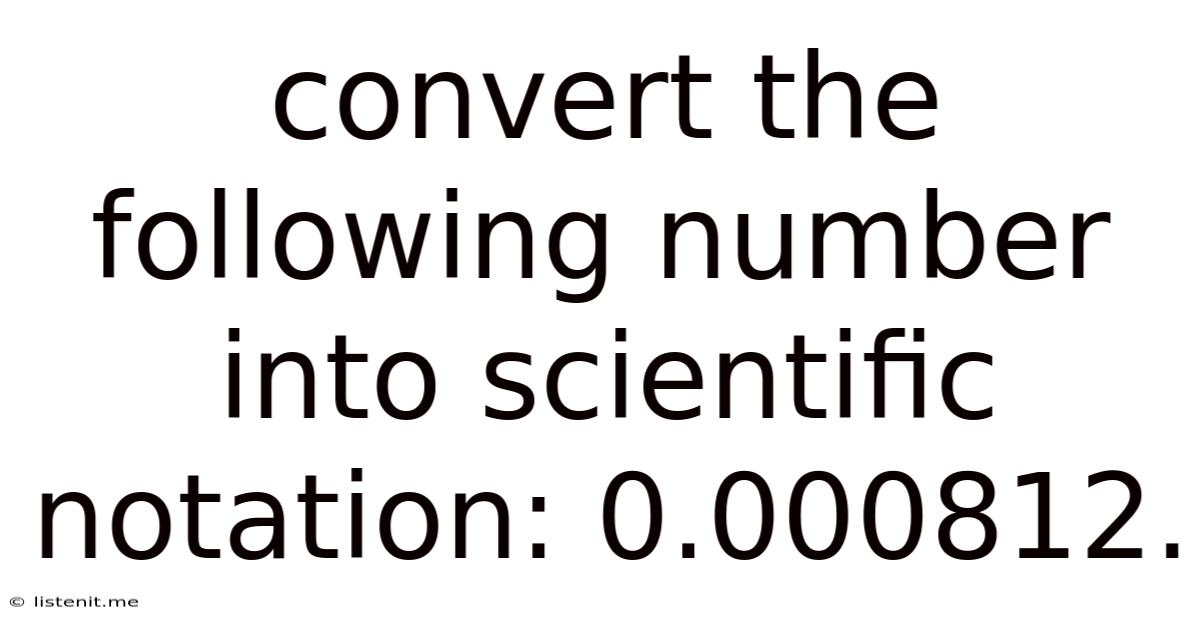Convert The Following Number Into Scientific Notation: 0.000812.
listenit
May 12, 2025 · 4 min read

Table of Contents
Converting Numbers to Scientific Notation: A Deep Dive into 0.000812
Scientific notation is a powerful tool used to represent very large or very small numbers in a concise and manageable format. It simplifies calculations and improves readability, especially when dealing with numbers encountered in scientific fields like physics, chemistry, and astronomy. This article will thoroughly explain how to convert the number 0.000812 into scientific notation, providing a comprehensive understanding of the process and its underlying principles. We'll also explore the broader applications and benefits of using scientific notation.
Understanding Scientific Notation
Scientific notation expresses a number as a product of two factors: a coefficient (or significand) and a power of 10. The coefficient is always a number between 1 and 10 (but not including 10), while the power of 10 indicates the magnitude of the number. The general form is:
a x 10<sup>b</sup>
where:
- a is the coefficient (1 ≤ a < 10)
- b is the exponent (an integer)
Converting 0.000812 to Scientific Notation: A Step-by-Step Guide
Let's break down the conversion of 0.000812 into scientific notation.
-
Identify the Coefficient: The first step involves identifying the coefficient. We need to move the decimal point to the right until we have a number between 1 and 10. In this case, we move the decimal point four places to the right, resulting in 8.12. Therefore, our coefficient (a) is 8.12.
-
Determine the Exponent: The exponent (b) represents the number of places the decimal point was moved. Since we moved the decimal point four places to the right, the exponent is -4. A negative exponent indicates that the original number is less than 1.
-
Combine the Coefficient and Exponent: Now, we combine the coefficient and the exponent to express the number in scientific notation:
8.12 x 10<sup>-4</sup>
Therefore, 0.000812 in scientific notation is 8.12 x 10<sup>-4</sup>.
Why Use Scientific Notation?
The benefits of using scientific notation extend beyond simply writing numbers more compactly. Here's a deeper look at its advantages:
1. Conciseness and Readability:
Scientific notation significantly reduces the length and complexity of very large or very small numbers. Imagine trying to write out Avogadro's number (approximately 602,214,076,000,000,000,000,000) without scientific notation – it's cumbersome and error-prone. In scientific notation, it's neatly represented as 6.022 x 10<sup>23</sup>. Similarly, small numbers like the charge of an electron (-0.00000000000000000016 coulombs) become manageable as -1.6 x 10<sup>-19</sup> C.
2. Simplified Calculations:
Calculations involving very large or very small numbers become much easier with scientific notation. When multiplying or dividing numbers in scientific notation, you can simply multiply or divide the coefficients and add or subtract the exponents, respectively. This streamlines the calculation process and reduces the likelihood of errors.
Example: (2 x 10<sup>3</sup>) x (3 x 10<sup>4</sup>) = (2 x 3) x 10<sup>(3+4)</sup> = 6 x 10<sup>7</sup>
3. Enhanced Accuracy:
Scientific notation helps maintain accuracy, especially when dealing with numbers with many significant digits. By focusing on the significant digits in the coefficient, you avoid unnecessary trailing zeros that can obscure the precision of the measurement.
4. Universal Understanding:
Scientific notation is universally adopted in scientific and engineering communities. This ensures clarity and avoids ambiguity when communicating numerical data across different contexts and geographical locations.
Beyond the Basics: Working with Scientific Notation
Once you understand the fundamentals of converting to scientific notation, you can expand your skills to encompass various operations:
1. Addition and Subtraction:
Adding or subtracting numbers in scientific notation requires adjusting the exponents to be the same before combining the coefficients. For example:
2.5 x 10<sup>3</sup> + 3.0 x 10<sup>2</sup> = 2.5 x 10<sup>3</sup> + 0.3 x 10<sup>3</sup> = 2.8 x 10<sup>3</sup>
2. Multiplication and Division:
Multiplication and division are generally easier. Multiply the coefficients and add the exponents for multiplication; divide the coefficients and subtract the exponents for division.
3. Converting from Scientific Notation to Standard Form:
Reversing the process involves moving the decimal point according to the exponent. A positive exponent shifts the decimal point to the right, while a negative exponent shifts it to the left.
Practical Applications of Scientific Notation
Scientific notation finds widespread applications across diverse fields:
- Physics: Describing distances in astronomy (light-years), the size of atoms, and fundamental physical constants.
- Chemistry: Representing Avogadro's number, molar masses, and the concentrations of solutions.
- Biology: Working with extremely small quantities like the number of cells in an organism.
- Computer Science: Handling large data sets and memory capacities.
- Engineering: Representing measurements and calculations involving large structures and precise tolerances.
- Finance: Working with large sums of money or tiny percentages.
Conclusion: Mastering Scientific Notation for Enhanced Numerical Proficiency
Scientific notation is a fundamental tool in various fields, offering conciseness, improved readability, simplified calculations, and enhanced accuracy when dealing with extremely large or small numbers. Understanding how to convert numbers like 0.000812 into scientific notation (8.12 x 10<sup>-4</sup>) is crucial for anyone working with numerical data. Mastering this skill provides a significant advantage in tackling complex problems and ensures clear communication of scientific findings. By understanding the principles outlined in this article, you can confidently navigate the world of scientific notation and its diverse applications.
Latest Posts
Latest Posts
-
A Metal That Is A Liquid At Room Temperature
May 12, 2025
-
How Are The Elements In The Modern Periodic Table Arranged
May 12, 2025
-
What Is The Decimal Of 13 20
May 12, 2025
-
Difference Between Atomic And Molar Mass
May 12, 2025
-
When An Iron Ring Is Heated The Hole Becomes
May 12, 2025
Related Post
Thank you for visiting our website which covers about Convert The Following Number Into Scientific Notation: 0.000812. . We hope the information provided has been useful to you. Feel free to contact us if you have any questions or need further assistance. See you next time and don't miss to bookmark.